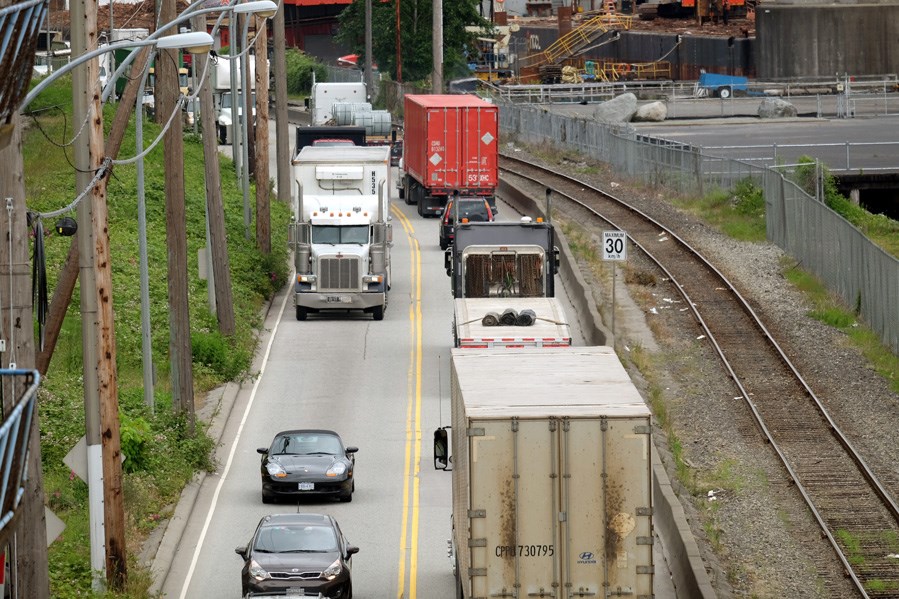New Westminster has given the green light to its master transportation plan.
After more than two years of studies and public consultation, New Westminster City Council has adopted the final version of its new master transportation plan. The plan will guide the city’s actions on transportation planning and investment for the next 25 years.
“The plan is great,” said Coun. Jonathan Cote, who co-chaired the master transportation plan committee. “It’s one thing. It’s just one thing with a piece of paper. It’s the implementation that really matters.”
Cote would like the city to consider how it will move forward with implementation of the plan.
A staff report outlines some of the goals of the plan to be implemented in the coming years:
* Creating a walkable community that ensures walking is a safe, convenient and universally accessible way to get around New West.
* Making cycling a comfortable and attractive way to move through the city for people of all ages and abilities.
* Providing attractive and convenient transit for trips within New Westminster and the region.
* Preserving neighbourhood livability by reducing the negative impacts of traffic through neighbourhood traffic calming and encouraging walking and cycling.
* Managing local and regional travel through the city, including regional goods movement.
The City of Burnaby recently voiced concerns about New Westminster’s goal of removing Royal Avenue, East Eighth Avenue, and portions of East Columbia Street and Ewen Avenue from the city’s truck route network. Burnaby city council voiced concerns about New Westminster's plan and voted in favour of authorizing its city staff to "engage in a detailed review of the various cycling, truck route and road classification issues arising from New Westminster's draft master transportation plan," highlighting concerns with cross-border cycling connections and the removal of regional truck traffic.
Burnaby Coun. Paul McDonell likened closing off one of those routes to plugging a leak, only to have another spring up elsewhere.
"The trucks are going to traffic, and every time you shut down one route, it just means they're going to blow up another one."
If New West eliminated some truck routes, Burnaby mayor Derrick Corrigan said the big rigs would detour through Burnaby, putting added stress on its city's roads.
"While I often side with New Westminster on issues like the Pattullo Bridge...there's a point where you've got to have a good neighbour policy to ensure we're all able to deal with the implications of decisions you're making in your own municipality,” he said.
Cote said Royal Avenue would be the route that has the most significant impact on New Westminster’s neighbours, but he believes that should be part of a larger discussion about the replacement of the Pattullo Bridge.
“We need to make sure our master transportation plan fits with the regional transportation plan. I think there might be a bit of an overreaction in terms of what we are talking about,” Cote told The Record. “Our plan still recognizes that New Westminster plays a role for a goods movement strategy, but we do have some routes that are going through neighbourhoods that are just not appropriate for major truck routes – and some that don’t even have a major demand.”
Cote believes removing the four proposed truck routes would have “minimal” impact on Burnaby.
“I think what New Westminster wants to try and do is try and find a good long-term solution for goods movement corridor. I think that would ultimately require support from other levels of government,” he said. “The long-term vision is actually to create some kind of bypass corridor that connects Stewardson all the way to Brunette, to really allow that bypass route for goods movement to go through.”
Burnaby Coun. Nick Volkow, a former truck driver, took issue with the idea of creating a three-kilometre tunnel near Third Avenue to divert truck traffic.
"I think most people in Metro Vancouver are aware of New Westminster's desire to have no truck traffic on their streets, which is an admirable goal," he said. "I dare say that truck traffic is probably not compatible with most cities' aspirations in the Lower Mainland, but the reality is in a major metropolitan area, truck traffic is part of the scenery.”
Cote said there is a huge demand for goods movement, and traffic overall, to move from the Queensborough Bridge and Marine Way to get to Highway 1, and the city needs to find a long-term solution to move goods through the city. Because New Westminster will never have the financial resources to be able to complete that kind of transportation route on its own, he said the city wants to have the concept and a detailed plan in place that articulates the city’s needs and how it would help the region’s transportation system, in case federal or provincial funding becomes available.
“Twenty-five per cent of New Westminster’s land base is currently dedicated to road use. There really is not a lot of room for major expansions of roadway unless we do things creatively like try and create a bypass tunnel,” he said. “Ultimately New Westminster is in a position where we have to try and manage the significant demand of our through-traffic. I think there are opportunities to try and make the routes we do have more efficient to move traffic, but there has to be a recognition that there’s not a lot of room in a 150-year old built-out city to dramatically expand the road capacity without having a pretty negative impact on our neighbourhoods.”



